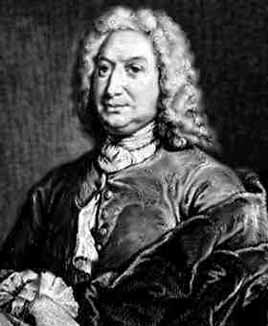
| The Bernoullis are a family of mathematicians. The most famous of them all are the brothers Jacob and Johann, whose father is Nicolaus (1623-1708). Among the wide range of Mathematics pertaining to the Bernoullis are Bernoulli Numbers, Bernoulli Differential Equation, Bernoulli's Principle of Fluid Dynamics, Bernoulli Trial, Bernoulli Inequality, etc. Jacob (1654-1705) is the first of the Bernoullis to make Mathematics a career, despite pressure to seek a career elsewhere. He contributed greatly to Calculus, Infinite Series and Probability. In particular, he published the Law of Large Numbers in 1689. This Law states that if an experiment of an event is carried out a large number of times, then the relative frequency of the event occurring equals the corresponding probability. | 
|
Among his other works are:
Jacob and Johann are responsible for promoting Gottfried William Leibniz's work on Calculus, as they were among the first to comprehend the theory of infinitesimals put forward by Leibniz. However, the two brothers are in constant rivalry over who is the better mathematician, so much so that their rivalry was known to the public community. One of the reason that the rivalry is so intense is that Johann could not ascend the chair of Mathematics in Basel because Jacob was holding it. It was only after Jacob's death that the chair was handed to Johann.
 |
Johann (1667-1748) is 12 years younger than Jacob and he learnt Mathematics under his brother. It took him only 2 years to equal his brother in mathematical skills. A well-known episode in his life is with regard to de L'H�pital. He was invited by L'H�pital to teach Calculus. Then, L'H�pital published a book on Calculus, which contained the lectures of Johann, but gave little credit to Johann. There was little Johann could do because he was forbidden, by an agreement, to claim authorship to the book. It is worthwhile to note that L'H�pital corrected many of the mistakes that Johann made. |
Johann solved the Catenery Problem (the curve of a hanging chain supported at its ends and acted upon by gravity) posed by Jacob in 1691. This problem was also solved by Leibniz, Huygens and Jacob himself. Johann worked on caustic curves jointly with his brother (1692-93). He contributed greatly to Differential Equations and Series in 1694. He proposed the Brachistochrone Problem in 1696. 5 correct solutions were submitted namely by Johann, Jacob, L'H�pital, Newton and Leibniz. In retaliation, Jacob proposed the Isoperimetric Problem, i.e. minimizing the area enclosed by a curve. Johann promptly solved this, but in 1718 he returned to the problem and presented a better solution. After Jacob's death, rivalry did not extinguish in the family. A new rivalry arose between Johann and his son, Daniel. It started when they jointly won the Grand Prize of the Paris Academy in 1734. Johann was not happy that his son was on par with him and this led to the ugly fight over who the real founder of Hydrodynamics is. Daniel published Hydrodynamica in 1738. Then in 1739, Johann published Hydraulica which is largely based on his son's work, but claimed that it was published in 1732.
| Daniel (1700-1782) is the founder of Hydrodynamics and the famous Bernoulli Principle. He published his first work, Mathematical Exercises in 1724 with Goldbach's help. There are four parts to this work. The first describes the game of faro and deals with Probability. The second is on the flow of water from a hole in a container. The third is on Riccati Differential Equation and the fourth is on figures bounded by two arcs of a circle. Subsequently, more important works started to pour out. In 1725, he invented an hour glass that has a constant sand flow even in rough seas. |  |
He worked with Leonhard Euler (Johann's pupil) in St Petersburg from 1727 to 1733. In 1728, Daniel and Euler investigated the Mechanics of flexible and elastic bodies, and discovered that the movement of strings is actually a superposition of infinite numbers of harmonics. Euler used his great mathematical insights and analytic skills to put many of Daniel's ideas on a rigorous stand. The companionship and exchange of ideas between them have proven very fruitful for both, and this carried on even after Daniel left St Petersburg.
During his time, Daniel was highly regarded in the scientific community throughout Europe and he won the Grand Prize of the Paris Academy 10 times in all. He worked on wide ranging topics like Magnetism, Nautical topics, Astronomy, Fluid Dynamics, Probability. He applied Probability to Economics and Insurance. He also discovered the basic laws of the Kinetic Theory of Gases.
It is interesting to note that two more of Johann's sons, Nicolaus(II) (1695-1726) and Johann(II) (1710-1790) also went on to become mathematicians. Other well-known mathematicians in the family are Nicolaus(I) (1687-1759), Jacob(II) (1759-1789) and Johann(III) (1744-1807). Nicolaus(I) was a nephew of Jacob Bernoulli and Johann Bernoulli. Jacob(II) and Johann(III) are both sons of Johann(II). It is also worth noting that Jacob(II) married a granddaughter of Euler.
Short notes on some of the mathematicians mentioned in this page.
1. Guillaume de L'H�pital (1661-1704) (French) is remembered for the
rule in Calculus named after him, namely L'H�pital's rule. This provide the
limit of a rational function when both its numerator and denominator tend to
zero together.
2. Christian Huygens (1629-1695) (Dutch) is one of the
greatest scientist-cum-mathematician in the 17th century. He
discovered the first moon of Saturn in 1655; he worked on pendulums (both simple
and compound), momentums, centripetal force, optics.
3. Christian
Goldbach (1690-1764) (Russian) is remembered for his famous 1742 conjecture,
which states that every even integer >2 is expressible as the sum of two
primes. Goldbach also conjectured that every odd number is expressible as the
sum of three primes.
Return to Maths Homepage